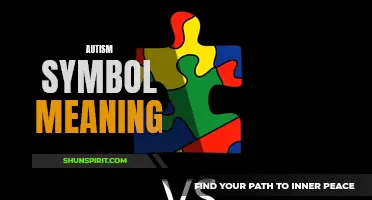
Wheels have been used as symbols in various cultures throughout history. They typically represent movement, progress, and cycles. In ancient mythology, the wheel symbolized the sun, with its continuous rotation representing the passage of time and the changing of seasons. In many spiritual traditions, the wheel is a symbol of life's journey and the interconnectedness of all things. Whether portrayed as a simple circular shape or a complex mandala, the wheel symbol holds deep significance and invites contemplation on the cyclical nature of existence and the continual flow of energy. Join us as we delve into the fascinating world of wheel symbolism and uncover its diverse meanings across different cultures and disciplines.
What You'll Learn
- What does the wheel symbolize in various cultures and religions?
- What is the significance of the wheel symbol in Buddhist teachings?
- How has the wheel symbol been used in mythological stories throughout history?
- Are there any specific symbolic meanings associated with the wheel in Native American cultures?
- How has the meaning of the wheel symbol evolved over time in different societies?

What does the wheel symbolize in various cultures and religions?
The wheel is a symbol that has been widely used in various cultures and religions throughout history. It carries different meanings and symbolism depending on the context and belief system. Let's delve into the significance of the wheel in a few selected cultures and religions.
In Hinduism, the wheel is an important symbol known as the "Chakra." It represents the cycle of birth, death, and rebirth, also known as samsara. The wheel reminds followers that life is a continuous process, and each turn of the wheel brings about new opportunities for growth and enlightenment. Additionally, the wheel symbolizes the cosmic order and the wheel of time, with its constant movement and change.
In Buddhism, the wheel is a powerful symbol associated with the teachings of the Buddha. Known as the "Dharmachakra," it represents the Noble Eightfold Path, which leads to the cessation of suffering and the attainment of nirvana. The wheel has eight spokes, each representing a different aspect of the path, including right view, right intention, right speech, right action, right livelihood, right effort, right mindfulness, and right concentration. By following the path, individuals can break free from the cycle of suffering and achieve spiritual liberation.
In Jainism, the wheel is known as the "Dharmachakra" or the "Navapada." It symbolizes the Jain concept of karma, which holds that every action has consequences and leads to a cycle of birth and death. The wheel reminds Jains of the importance of leading a righteous life, as it will determine their future rebirths. Jainism also uses a specific wheel symbol called the "Ahimsa Chakra," which represents non-violence and peace.
In Christianity, the wheel is often associated with divine providence and the wheel of fortune. It represents the ever-turning cycles of life, with its ups and downs. The wheel's rotation serves as a reminder that everything in life is temporary, and one must remain steadfast in their faith and trust in God's plan. Furthermore, the wheel can symbolize the resurrection of Jesus, as it echoes the image of a stone being rolled away from the entrance to his tomb.
In Native American cultures, the wheel symbolizes the circle of life and the interconnectedness of all things. It represents the cycles of nature and the changing seasons. Native American tribes often use medicine wheels, which are large stone structures arranged in a circular pattern, to symbolize spiritual energy and harmony. These wheels serve as sacred sites for ceremonies, reflection, and connection with the natural world.
Overall, the wheel symbolizes various themes and concepts in different cultures and religions. It represents the cyclic nature of life, the path to enlightenment, the laws of karma, divine providence, and the interconnectedness of all beings. Regardless of its specific interpretation, the wheel serves as a reminder of the inherent dynamism and constant change within the human experience.
Understanding the Symbol Meanings on the Pro1 Thermostat
You may want to see also

What is the significance of the wheel symbol in Buddhist teachings?
The wheel, commonly known as the "Dharmachakra," is one of the most significant symbols in Buddhist teachings. It holds deep symbolic meaning and is often used to represent key concepts in Buddhism.
The wheel symbolizes the teachings of the Buddha and the path to enlightenment. Just as a wheel revolves endlessly, the wheel of Dharma represents the continuous cycle of birth, suffering, and rebirth in the world. The teachings of the Buddha, known as the Dharma, provide a way for individuals to break free from this cycle and attain enlightenment.
The wheel is usually depicted with eight spokes, which represent the noble eightfold path – the guiding principles for individuals on their spiritual journey. These eight spokes stand for right view, right intention, right speech, right action, right livelihood, right effort, right mindfulness, and right concentration. By following these principles, individuals can cultivate wisdom, ethical conduct, and mental discipline, ultimately leading them to liberation.
Furthermore, the wheel represents the Buddha's first sermon, known as the "Turning of the Wheel of Dharma." In this sermon, the Buddha taught the four noble truths, which are the foundation of Buddhist teachings. The first noble truth acknowledges the existence of suffering, the second identifies the cause of suffering as attachment and craving, the third proposes the cessation of suffering through the elimination of these attachments, and the fourth suggests the noble eightfold path as the means to achieve liberation.
The wheel of Dharma is often depicted as a wheel with spokes turning at the center. This imagery symbolizes the constant turning of the wheel of life, with the spokes representing different aspects of existence. It reminds practitioners that all things are impermanent and interconnected.
The wheel symbol can be found in various Buddhist art forms and religious sites. It is prominently featured in Buddhist temples, monasteries, and shrines, as well as on religious artifacts such as prayer wheels and prayer flags. These visual representations serve as reminders to practitioners of the Buddha's teachings and the importance of spiritual cultivation.
In conclusion, the wheel symbol holds great significance in Buddhist teachings. It represents the continuous cycle of birth and rebirth, the noble eightfold path, and the Buddha's first sermon. It serves as a reminder of the impermanence of all things and the interconnectedness of existence. The wheel of Dharma is a powerful symbol that guides individuals on their path to enlightenment and liberation.
The Meaning Behind the Box With X Symbol
You may want to see also

How has the wheel symbol been used in mythological stories throughout history?
The wheel is a powerful and ancient symbol that has been used in mythological stories throughout history. Its motif and meaning have varied across different cultures and time periods, but it often represents the cyclical nature of life, fate, and the constant movement of the universe.
In Greek mythology, the wheel symbol is often associated with the goddess Fortuna or Tyche, who was known as the personification of luck and fortune. She was often depicted holding a wheel, which represented the unpredictability of fate. It was believed that Fortuna could spin the wheel at any moment, bringing wealth and success to some and misfortune to others. The wheel also symbolized the ever-changing nature of life and the need to adapt to one's circumstances.
In Hindu mythology, the wheel symbol is associated with the god Vishnu, who is considered the preserver and protector of the universe. Vishnu is often depicted with a wheel, known as the Sudarshana Chakra, which represents his cosmic power and ability to maintain order and balance. The wheel is believed to have the power to cut through ignorance and illusion, bringing enlightenment and liberation to those who seek it.
In Celtic mythology, the wheel symbol is often associated with the sun. The Celts believed that the sun traveled across the sky in a wheel-like fashion, bringing light and warmth to the earth. The wheel symbolized the seasonal cycle and the eternal cycle of life, death, and rebirth. It also symbolized the perpetual movement of the natural world and the interconnectedness of all things.
In Norse mythology, the wheel symbol is associated with the goddess Freya, who was known as the goddess of love and beauty. She was often depicted riding a cart or chariot pulled by two cats, which symbolized her power and independence. The wheel represented the journey of life and the pursuit of knowledge and self-discovery.
In Buddhism, the wheel symbol, known as the Dharmachakra, represents the teachings of the Buddha. It is believed to be a representation of the Noble Eightfold Path, which is the path to enlightenment and liberation from suffering. The wheel symbolizes the continuous cycle of birth, death, and rebirth and the need to break free from this cycle through spiritual practice and enlightenment.
Throughout various mythological stories, the wheel symbol has been used to convey powerful and complex ideas about fate, destiny, and the cyclical nature of life. It represents the ever-changing and interconnected nature of the universe and the need to navigate and adapt to the constant movement of life. Whether associated with luck, cosmic power, the sun, love, or spiritual enlightenment, the wheel symbol holds deep significance in mythological stories and continues to resonate with people today.
Exploring the Profound Symbolism Behind the Nirvana Symbol
You may want to see also

Are there any specific symbolic meanings associated with the wheel in Native American cultures?
The wheel holds a significant symbolic meaning in Native American cultures. It is commonly regarded as a representation of the cycle of life, the four directions, and the interconnectedness of all things.
In many Native American tribes, the wheel is used as a powerful symbol of the circle of life. The wheel represents the never-ending cycle of birth, death, and rebirth. Just as the wheel turns, seasons change, and new life emerges, Native Americans believe that life is a continuous cycle of growth, transformation, and renewal. The wheel also symbolizes the eternal nature of the spirit, which is believed to come full circle after death, returning to the spirit world and eventually reincarnating into a new life.
The four directions play a vital role in Native American cultures, and the wheel represents these directions. Each direction holds specific meanings and is associated with different elements, animals, and colors. The East represents the rising sun, new beginnings, and the element of fire. The South represents youth, growth, and the element of earth. The West symbolizes the setting sun, maturity, and the element of water. Lastly, the North represents wisdom, old age, and the element of air. The wheel brings together these directions and signifies the balance and harmony found within nature and the universe.
Furthermore, Native Americans view the wheel as a symbol of the interconnectedness of all things. It represents the idea that everything in the universe is connected and part of a greater whole. Just as the spokes of a wheel are intertwined and depend on each other for stability, Native Americans believe that all living beings and elements of nature are interconnected and reliant upon one another. The wheel symbolizes the importance of unity, respect for all life, and the understanding that every action has consequences that ripple throughout the interconnected web of life.
The wheel's symbolic meanings can vary slightly between different Native American tribes, as each tribe has its own unique traditions and interpretations. However, the underlying themes of the cycle of life, the four directions, and the interconnectedness of all things remain prevalent throughout Native American cultures.
In conclusion, the wheel holds a deep symbolic meaning in Native American cultures. It represents the cycle of life, the four directions, and the interconnectedness of all things. The wheel serves as a reminder of the continuous flow of life and the importance of respecting and honoring the natural world and all its inhabitants.
The Significance of Peace Symbols: Unlocking Their Meanings
You may want to see also

How has the meaning of the wheel symbol evolved over time in different societies?
The wheel is one of the oldest and most universal symbols in the world. It has been used by various civilizations throughout history, and its meaning has evolved over time in different societies. From its early origins as a simple means of transportation to its modern interpretations as a symbol of progress and unity, the wheel has maintained its significance and power.
In ancient civilizations such as Mesopotamia and Egypt, the wheel was primarily associated with transportation. It allowed for the movement of goods and people, revolutionizing trade and communication. In these societies, the wheel became a symbol of progress and innovation, representing the advancement of civilization.
As different cultures came into contact with the wheel, its symbolic meaning began to change. In ancient Greece, the wheel was associated with fate and destiny. The Greek goddess Fortuna, who was responsible for the distribution of fortune and misfortune, was often depicted with a wheel to symbolize the unpredictability of life. The wheel became a reminder of the cyclical nature of human existence and the constant changes and uncertainties we face.
In Hindu and Buddhist traditions, the wheel, known as the dharma chakra, is a sacred symbol that represents the path to enlightenment. It is often depicted with eight spokes, which symbolize the Noble Eightfold Path, a set of principles that lead to spiritual awakening. The wheel represents the cycle of birth, death, and rebirth, and serves as a reminder of the impermanence of life.
In more recent times, the wheel has taken on additional meanings in the context of technology and progress. With the invention of the steam engine and the rise of the industrial revolution, the wheel became a symbol of mechanization and modernity. It represented the power and potential of human invention and the ability to overcome obstacles through innovation.
In the modern era, the wheel has also become a symbol of unity and interconnectedness. The Olympic Games, for example, feature the Olympic rings, which represent the five continents coming together in peaceful competition. The wheel has also been used to symbolize the interconnectedness of different facets of society, such as the economy, politics, and culture.
Overall, the meaning of the wheel symbol has evolved over time in different societies, reflecting the changing values, beliefs, and aspirations of humanity. Its significance as a symbol of progress, fate, spiritual awakening, mechanization, and unity demonstrates the enduring power and versatility of this ancient and universal symbol.
Understanding the Symbol Dayz Icon Meanings: A Guide for Players
You may want to see also
Frequently asked questions
The wheel symbol is often associated with movement, progression, and change. It represents the cycle of life and is a symbol of time and eternity. It can also symbolize the circle of karma, representing the idea that our actions and choices will come back to us in the future.
Yes, the wheel symbol holds cultural significance in various religions and traditions. In Hinduism, it is known as the Dharma Wheel and represents the path to enlightenment. In Buddhism, it symbolizes the teachings and guidance of the Buddha. In Celtic mythology, the wheel symbolizes the wheel of the year and the changing seasons.
Yes, the design of the wheel symbol can vary, and this can influence its meaning. For example, a wheel with eight spokes is commonly associated with Buddhism and represents the Noble Eightfold Path. A wheel with four spokes can symbolize the four elements or the four cardinal directions.
In spiritual and esoteric traditions, the wheel symbol often represents the cycle of life, death, and rebirth. It can also symbolize the harmony and interconnectedness of all things. Some believe that meditating on the wheel symbol can help bring balance and alignment to one's life and spiritual journey.
The wheel symbol can be used as a personal symbol to represent one's own journey and growth. It can remind us to embrace change and adapt to the cycles of life. Some people may choose to wear a wheel symbol as jewelry or incorporate it into tattoos or artwork as a visual reminder of these meanings.







